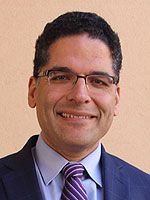Device aimed at replacing metal implants that often require removal due to pain, irritation
By Lynn M. Lessard
An adaptive surgical device invented several years ago by a team of researchers with The University of New Mexico’s Orthopaedics & Rehabilitation for improved support and healing of knee, elbow and sternum fractures has been issued a United States patent. The design team now seeks to license and manufacture the mesh plate as a viable alternative device for treating fractured bone that underlies a thin layer of soft tissue.
“Many existing surgical implants are rigid plates with few screw placement options which experience rejection rates more than 50 percent of the time,” said Christina Salas, assistant professor and director of UNM’s Orthopaedics Biomechanics & Biomaterials Laboratory. “But our high-tension mesh device precisely molds to bony contours for enhanced compression. It also features numerous crimped links which can accommodate multiple bone screws for improved stability. These benefits can prevent costly secondary surgeries and speed up rehabilitative healing.”
Salas came up with the patented design after studying mesh devices used to treat facial fractures. Co-inventers of the new mesh plate include: Mahmoud Reda Taha, professor and chair of UNM Civil Engineering; Dr. Leroy Rise, a former UNM Orthopaedics fellow and current orthopaedic surgeon with CHRISTUS St. Vincent Regional Medical Center in Santa Fe, NM; and Dr. Aaron Dickens, a former UNM Orthopaedics resident who now performs orthopaedic trauma surgery with Great Basin Orthopaedics in Reno, Nev.
“Our mesh plate can be produced from a variety of materials to avoid metallic implant corrosion and breakdown,” said Salas.
She points out that the device’s improved technology is designed “to outperform” larger compression plates and steel-wire fracture repair techniques currently in use. The patented device is specifically configured to resist high-tension stresses to knee, elbow and sternum fracture but can potentially be used to treat other types of fractures that require surgical implants just below the skin.
For more information, visit UNM Orthopaedics Research.


